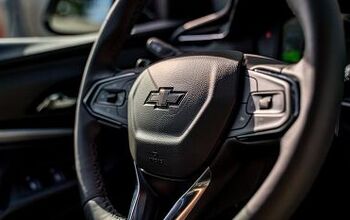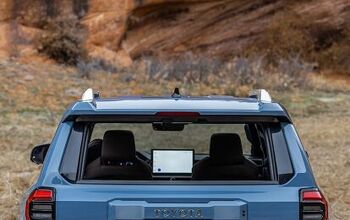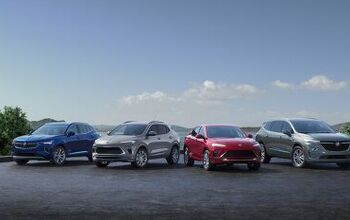How Sports Are Your Cars? We Have Answers
Even Mazda, we told you last week, is now selling more crossovers than cars.
One-third of Chevrolet’s U.S. volume is produced by pickup trucks. An SUV now generates more than half of the Bentley brand’s U.S. sales. Half of all Chrysler buyers choose a minivan.
Where are the sports cars?
We don’t expect auto brands to produce the majority of their volume with sports cars. In fact, many auto brands don’t sell any kind of sports car at all. But at TTAC, we’re enthusiasts, even though some of us drive minivans and three-cylinder subcompact hatchbacks and compact sedans. We want sports cars to be part of an automaker’s lineup because there will come a day.
But which auto brands actually produce meaningful volume with sports cars?
To answer this question we ignored “performance versions” of four-door sedans. We excluded coupe variants of sedans for which sales figures either are or are not made available by their respective automakers. And we rejected from contention two-doors such as the Buick Cascada in the interests of our reputation. (Yes, you can argue about the Dodge Challenger’s reputation as a “sports car” and whether it’s essentially just a two-door Charger, but we included it anyhow.)
And then, to reach a conclusion, we also tossed out sales of crossovers, SUVs, vans, and pickup trucks. The real question becomes: which mainstream auto brands produce the greatest percentage of their passenger car sales from sports cars?
Toyota | 1%
Through the first eight months of 2016, the FR-S accounted for 0.7 percent of total Toyota/Scion car volume. For every FR-S sold by Scion, Toyota also sells 52 Camrys, 48 Corollas, and 45 RAV4s.
Nissan | 1%
Now, with SUVs/crossovers bringing in more than one-third of Nissan sales, 370Z volume a fraction of what it was, and the GT-R reporting an expected level of niche volume, only one-half of one percent of Nissan’s total volume is sports car-derived.
Subaru | 3%
But we’re not talking about rally-inspired sedans. The Subaru BRZ, a twin of the Scion FR-S/Toyota 86, is down 20 percent to 3,062 sales this year, representing just 3 percent of Subaru’s 107,203 car sales in 2016’s first eight months.
Mazda | 7%
Possibly the most famous Mazda, the MX-5 Miata produces only 7 percent of the brand’s U.S. passenger car volume; only 4 percent of the brand’s total volume.
Fiat | 7%
In August, for instance, as sales of the 500 and 500L fell 43 percent to 1,374 units, Fiat sold 460 copies of the 124 Spider, or 25 percent of the brand’s passenger car volume.
Chevrolet | 14%
Combined sales of Chevrolet’s two entry-level models, the Sonic and Spark: 62,716.
Ford | 17%
With 80,829 year-to-date sales, the Mustang outsells the C-Max, Fiesta, and Taurus combined.
Dodge | 31%
Because of the Dart’s upcoming disappearance, Dodge car sales are down by nearly a fifth this year. Nearly six in ten Dodge sales come from the “light truck” division: Grand Caravan, Durango, Journey.
Timothy Cain is the founder of GoodCarBadCar.net, which obsesses over the free and frequent publication of U.S. and Canadian auto sales figures. Follow on Twitter @goodcarbadcar and on Facebook.
More by Timothy Cain
Latest Car Reviews
Read moreLatest Product Reviews
Read moreRecent Comments
- Probert They already have hybrids, but these won't ever be them as they are built on the modular E-GMP skateboard.
- Justin You guys still looking for that sportbak? I just saw one on the Facebook marketplace in Arizona
- 28-Cars-Later I cannot remember what happens now, but there are whiteblocks in this period which develop a "tick" like sound which indicates they are toast (maybe head gasket?). Ten or so years ago I looked at an '03 or '04 S60 (I forget why) and I brought my Volvo indy along to tell me if it was worth my time - it ticked and that's when I learned this. This XC90 is probably worth about $300 as it sits, not kidding, and it will cost you conservatively $2500 for an engine swap (all the ones I see on car-part.com have north of 130K miles starting at $1,100 and that's not including freight to a shop, shop labor, other internals to do such as timing belt while engine out etc).
- 28-Cars-Later Ford reported it lost $132,000 for each of its 10,000 electric vehicles sold in the first quarter of 2024, according to CNN. The sales were down 20 percent from the first quarter of 2023 and would “drag down earnings for the company overall.”The losses include “hundreds of millions being spent on research and development of the next generation of EVs for Ford. Those investments are years away from paying off.” [if they ever are recouped] Ford is the only major carmaker breaking out EV numbers by themselves. But other marques likely suffer similar losses. https://www.zerohedge.com/political/fords-120000-loss-vehicle-shows-california-ev-goals-are-impossible Given these facts, how did Tesla ever produce anything in volume let alone profit?
- AZFelix Let's forego all of this dilly-dallying with autonomous cars and cut right to the chase and the only real solution.










































Comments
Join the conversation
I've heard that a sports car has to have a manual transmission (okay, transaxle). This would exclude anything currently made by Ferrari, but would include the Buick Regal. I have also heard that a sports car cannot have a back seat. This would exclude the Porsche 911 (or the late 944, 924 or 928), but include the panel delivery version of the late, unlamented Chevrolet HHR. And a sports car should only have two doors. Include the rental-car variants of the Camaro, Challenger and Mustang; exclude the GTI, WRX and Evo. In other words, it's all but impossible to define what is and what is not a sports car. And all but pointless to try.
The Challenger is not even close to being a sports car.